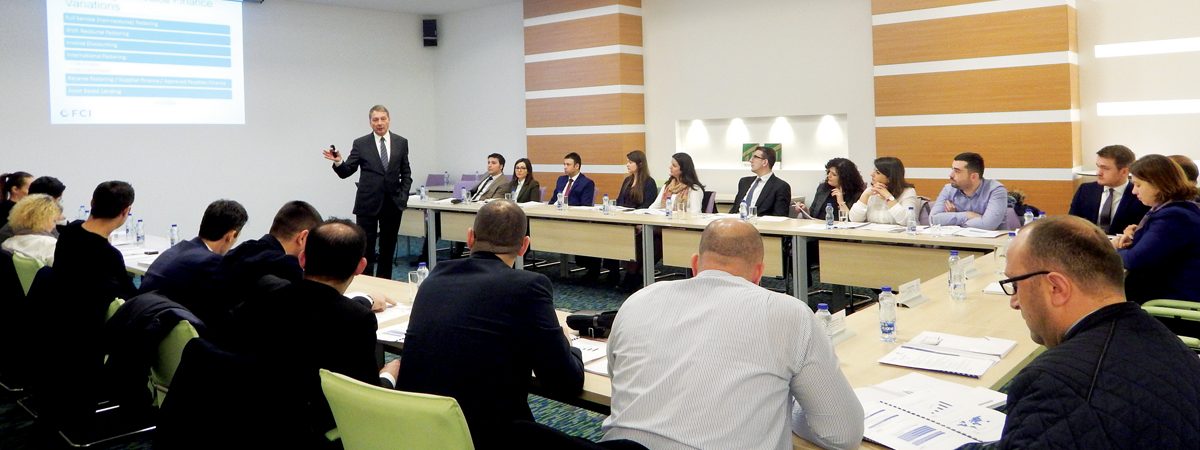
![]()
The TFP was established to build skills in partner banks and foster relationships with foreign commercial banks.
The TFP has arguably had its best year to date. The programme’s business volume rose to €1.54 billion in 2016 from €867 million in 2015. And in terms of individual countries, Ukraine generated the highest number of transactions, followed by Armenia, Cyprus, Belarus and Serbia.
What’s more, in 2017 the readers of Euromoney’s Trade Finance magazine, Global Trade Review and Global Finance voted the EBRD “Best Development Bank in Trade Finance”.
Combine all of that with our 20,000th transaction and launch of our “Green TFP” facilities things seem to be going from strength to strength.
Helping the smaller banks
However, foreign commercial banks are increasingly reluctant to establish trade finance facilities for smaller TFP partner banks due to the high cost of compliance. It costs a bank the same, or even more, to carry out compliance for a small bank offering limited business than a larger bank offering more opportunities. This has the unfortunate effect of blocking out the most vulnerable from correspondent relationships.
The TFP is therefore developing a technical cooperation project under which consultants employed by the EBRD will help TFP partner banks put together standardised compliance reports which will be regularly updated and meet the reporting requirements of the EBRD and most major foreign confirming banks in different jurisdictions.
Technical cooperation has continued to develop and strengthen organisational capacities in trade finance, improve know-how and, more generally, help EBRD trade finance operations to contribute more effectively to a country’s transition to a market economy.
To achieve these objectives a range of tools are provided, including advisory services tailored to the needs of individual partner banks, training workshops and innovative internet-based training.
One need only look to banks in Armenia, Belarus, Georgia and Mongolia to see how successful this has been; a few years ago, banks in these countries still needed TFP support for most of their trade finance transactions, whereas now they can finance significant parts of their trade finance business with facilities provided by foreign commercial banks.

The future
The TFP was established to build skills in partner banks and foster relationships with foreign commercial banks and indeed the programme has helped more than 170 partner banks to establish a track record in trade finance.
However, this is no longer our key objective (although a small number of new partner banks will continue to be added each year). Our main objective now is to ensure that our partners can sustain trade flow, especially in times of market disruption.
While the more advanced countries in central Europe and the Baltic states do not need our support anymore, TFP guarantee cover is still required by banks in the CIS (Commonwealth of Independent States) countries and less advanced countries in the Western Balkans.
A partner bank survey in 2015 showed that 73 per cent of partner banks required continuous TFP support for trade finance transactions that foreign commercial banks are unable or unwilling to finance, and 46 per cent of partner banks (all of them small or medium-sized banks) needed the programme to support most or all of their trade finance transactions.
We expect that smaller banks, banks in countries in the early stages of transition and banks in countries with higher country risk, such as Ukraine, will need TFP facilities for most or all of their trade finance business for the foreseeable future.
Over the past years we have seen demand for TFP support also in the Bank’s newer countries of operations, such as Greece, Cyprus and the southern and eastern Mediterranean (SEMED) region.
Larger TFP partner banks in SEMED benefit from a high number of trade finance facilities provided by foreign commercial banks. However, in most cases these facilities are only available for smaller transactions and for tenors of up to 6-12 months.
TFP facilities are needed for larger transactions and transactions with longer tenors. An example of a larger transaction guaranteed by the TFP was the import of grain silos into Egypt, financed through a letter of credit with a tenor of 18 months. Egypt is one of the largest importers of grain and the silos will increase Egypt’s grain storage capacity.
As for Greece and Cyprus, most foreign commercial banks are still unwilling to undertake any unsecured trade finance activity there. The most active confirming banks have reduced their country limits and tenor lengths. TFP facilities are supporting trade flows and encouraging confirming banks to maintain relationships with selected partner banks until their commercial trade finance facilities are reinstated to suitable levels.
www.ebrd.com/tfp73% of partner banks required continuous TFP support for trade finance transactions
Partner bank survey, 2015


